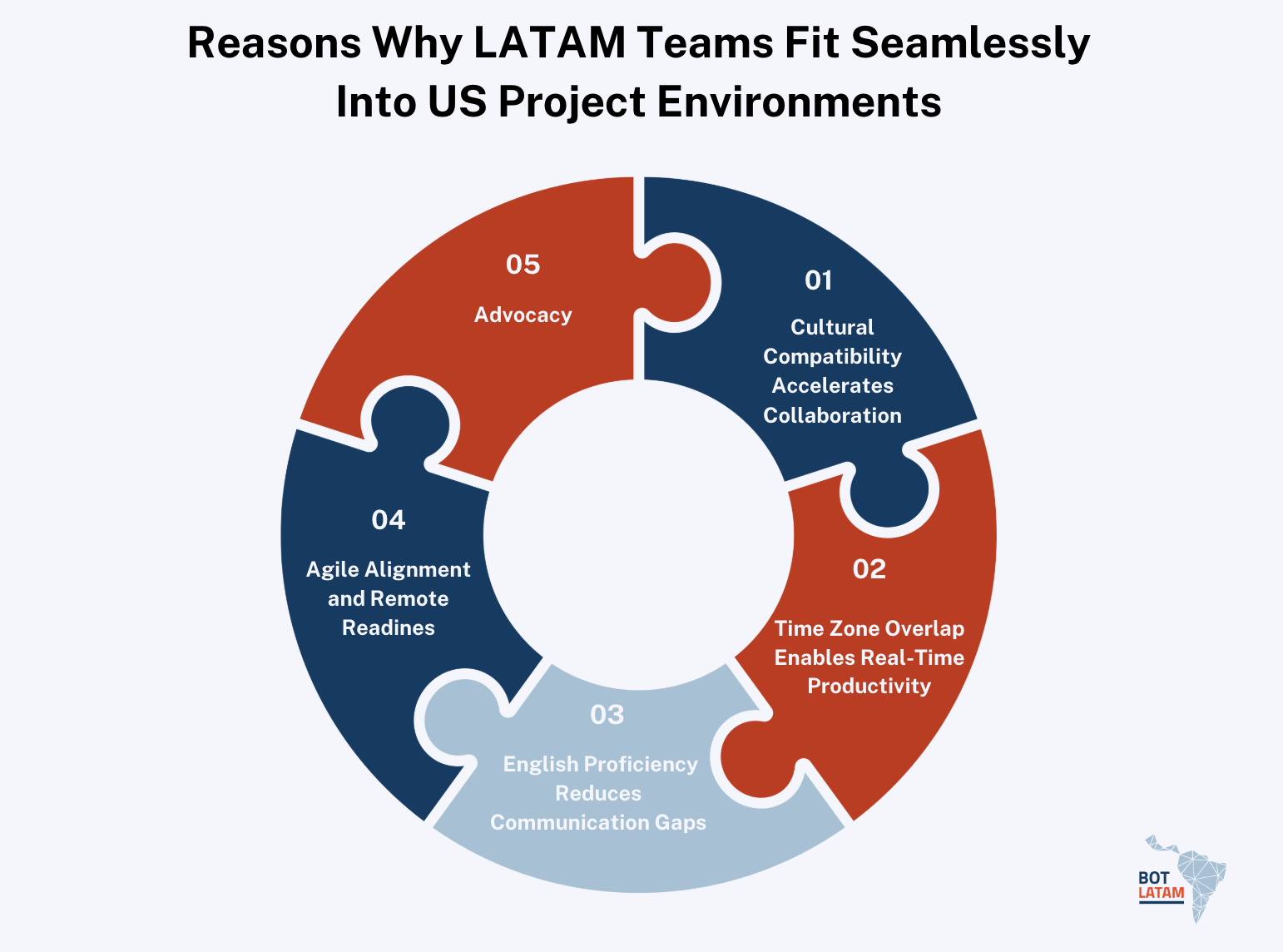Looking to expand your tech team without the usual hiring headaches? Latin America (LATAM) might be your smartest move. US companies are increasingly turning to LATAM for software development, DevOps, UX design, and more. And it’s not just about lower costs. With 85% of LATAM developers working in real-time US hours and strong cultural alignment, collaboration feels natural, not forced, according to NEO Group.
This article breaks down why LATAM nearshore teams are thriving in US-based projects. You'll discover where these teams fit best, what makes them so compatible with US operations, and how they drive real synergy in cross-border work. From technical skills to communication strengths, here's what makes LATAM teams a strategic asset for US tech growth. Keep reading to learn more!
The 5 Main Reasons Why LATAM Teams Fit Seamlessly Into US Project Environments

LATAM nearshore teams aren’t just a convenience; they’re built for compatibility with US-based tech operations. Their working style, communication habits, and real-time availability match closely with what US companies need to run agile, fast-moving projects.
1. Cultural Compatibility Accelerates Collaboration:
LATAM professionals share many workplace values with their US counterparts, direct communication, accountability, and an iterative mindset. This cultural alignment reduces misunderstandings and avoids the “lost in translation” delays that often occur with far-off offshore teams. According to Deloitte, companies that prioritize cultural compatibility in global teams see project cycle times improve by up to 30%.
Business etiquette also lines up. LATAM teams are used to US-style project planning, daily standups, and agile retrospectives. They’re comfortable pushing back when something doesn’t make sense, a trait that leads to stronger outcomes.
2. Time Zone Overlap Enables Real-Time Productivity:
Most LATAM countries operate within one to four hours of US time zones. That’s a huge win for coordination. Unlike offshore teams in Asia or Eastern Europe, LATAM developers can attend daily meetings, fix issues as they arise, and collaborate live with your internal staff.
A 2023 Accelerance report found that 85% of nearshore LATAM developers work on synchronized schedules with US clients, significantly reducing turnaround times on sprints, bug fixes, and feature rollouts.
3. English Proficiency Reduces Communication Gaps:
LATAM’s tech talent pool has made serious strides in English fluency. Countries like Argentina and Uruguay now rank among the highest in English proficiency across Latin America, according to the EF English Proficiency Index.
For US-based teams, that means fewer communication breakdowns, clearer documentation, and more effective collaboration tools usage, from GitHub comments to Slack threads.
4. Agile Alignment and Remote Readiness:
LATAM developers are highly familiar with agile workflows. Whether it’s Scrum, Kanban, or SAFe, most teams are already operating with sprints, user stories, and continuous integration pipelines. You won’t need to teach them your process; they’ll jump in and adapt fast.
Even more, many LATAM engineers have been working in remote-first or hybrid setups long before it became standard in the US. They know how to self-manage, communicate asynchronously, and maintain visibility through different tools.
5. Regional Tech Ecosystems Mirror US Expectations:
Cities like Medellín, Buenos Aires, and São Paulo are producing engineers trained in the same frameworks, programming languages, and cloud platforms used by Silicon Valley startups. LATAM universities and coding bootcamps are increasingly aligned with US standards and employer expectations.
This technical alignment cuts onboarding time and lowers the learning curve on cross-border projects. The result? Faster integration, fewer errors, and a stronger sense of shared ownership across distributed teams.
The Synergy Between LATAM Teams and US Tech Projects:
When collaboration flows, productivity scales. That’s exactly what happens when LATAM teams integrate with US-based tech projects. The synergy isn’t just about convenience, it’s about alignment in pace, expectations, and problem-solving.
Shared Work Hours Enable Immediate Feedback Loops.
LATAM teams operate in the same or adjacent time zones as the US. This allows for continuous feedback during core working hours, a clear advantage over regions that operate on a 10+ hour time difference. According to Statista, nearshore collaborations reduce feedback delays by up to 40%, helping projects stay agile and responsive.
Standups, sprint reviews, and ad-hoc brainstorming can happen live, not overnight. That makes decision-making quicker and less fragmented across teams.
Cross-Team Ownership Strengthens Product Quality.
LATAM engineers aren’t just executors, they often take full ownership of their workstreams. Many are trained to contribute beyond code, including suggesting architecture changes, automating test suites, or improving deployment pipelines.
This active participation builds joint accountability. Instead of working in silos, LATAM teams often mirror the structure and communication rhythms of internal US teams, reducing handoff friction and boosting codebase consistency.
Tools and Tech Stacks Align Seamlessly.
Tech stack compatibility is another reason synergy is so strong. LATAM teams commonly work with the same tools used by US teams, Python, Kubernetes, and more.
Jira, Figma, and CI/CD tools like Jenkins or GitLab are already part of the LATAM workflow. That means zero ramp-up time on platforms and less confusion during sprints or incident responses.
LATAM Teams Adapt Quickly to US Market Demands.
Speed matters in US tech projects, especially when launching MVPs or scaling fast. LATAM developers are well-versed in adapting to shifting priorities, tight deadlines, and real-time market feedback.
A 2024 report from Stack Overflow Talent noted that LATAM devs working with US firms showed a 28% faster average sprint cycle completion compared to offshore teams outside the Americas. That’s the type of velocity US product teams value most.
Familiar Business Norms Improve Strategic Execution.
You won’t need to explain what a product roadmap is or why continuous delivery matters. LATAM teams tend to have prior experience working with US-based companies, venture-backed startups, and enterprise clients. They understand tech debt, scalability planning, and the importance of user-centered design.
This baseline familiarity shortens the strategic alignment phase, allowing your team to shift from onboarding to output faster.
Innovation Emerges From Mutual Trust.
Long-term synergy depends on trust. LATAM teams who work consistently with US companies develop deep domain knowledge, not just of your codebase, but of your industry, your customers, and your goals.
That trust, built through transparency and real-time collaboration, often leads to better ideas, stronger features, and more scalable systems. Over time, you’re not just outsourcing, you’re co-creating.
LATAM Developer Skills That Meet US Market Demands
Technical alignment is one of the strongest advantages LATAM teams bring to US-based tech projects. Developers across Latin America are trained in the same frameworks, cloud platforms, and modern architectures you expect in a US-based engineering team.
Core Programming Languages and Frameworks Are Industry Standard:
LATAM developers are proficient in the most in-demand stacks. According to the 2024 Stack Overflow Developer Survey, the top languages used in Latin America include JavaScript, Python, Java, TypeScript, and SQL, mirroring US developer trends.
Frameworks like React, Angular, Node.js, Django, and Spring Boot are widely taught in LATAM bootcamps and CS programs. That means less time spent on training and more time building.
Cloud and DevOps Skills Are Well-Established:
Most LATAM software engineers have real-world experience working with cloud platforms like AWS, Google Cloud, and Azure. DevOps practices are also well-integrated into local workflows.
In a 2023 report from Coursera’s Global Skills Index, Brazil and Mexico ranked in the top 30 globally for cloud computing proficiency. This includes CI/CD, Docker, Kubernetes, and infrastructure-as-code tools like Terraform.
Strong Frontend and UX Focus for Scalable Interfaces:
LATAM isn’t just backend-heavy. Frontend engineers in the region are deeply experienced in designing responsive, user-friendly interfaces using tools like Tailwind CSS and Webflow.
Many teams also contribute to mobile app projects, using React Native and Flutter for cross-platform builds. That versatility gives US companies room to scale across devices with one regional partner.
AI, Data Engineering, and Machine Learning Capabilities Are Growing Fast:
LATAM universities are investing heavily in applied AI, machine learning, and data science programs. Countries like Argentina and Colombia now offer postgraduate AI certifications aligned with TensorFlow, PyTorch, and OpenAI ecosystems.
According to LinkedIn’s 2024 Emerging Jobs Report, roles like data engineer, machine learning engineer, and AI specialist are among the fastest-growing across LATAM markets. That growth is backed by real use cases, not just theory.
LATAM Developers Are Industry-Certified and Globally Competitive:
Many developers in the region pursue globally recognized certifications, AWS Certified Developer, Google Cloud Associate Engineer, and more. These credentials are increasingly seen in LATAM resumes and LinkedIn profiles.
As of 2024, over 320,000 AWS certifications have been earned across Latin America, according to AWS. That number continues to climb as more engineers build skills for enterprise-grade US projects.
Strong Documentation and Testing Practices:
Beyond code, LATAM developers are trained to write solid documentation, create test cases, and build with maintainability in mind. Whether you're running unit tests, integration tests, or end-to-end pipelines, quality assurance is part of the workflow, not an afterthought.
That attention to software lifecycle detail ensures smoother handoffs and cleaner codebases over time. It’s one of the quiet advantages that shows up when velocity and stability both matter.
Ready to Get Started with BOT Latin America?
LATAM development teams aren’t just a temporary solution, they’re a long-term strategic asset for US tech companies looking to scale with agility, reduce risk, and maintain high engineering standards. With over 1 million software developers across the region and a growing number of them working with US-based startups and enterprises, the infrastructure is already in place to support complex, fast-moving projects, according to IDC.
At BOT LATAM, we specialize in helping US companies build and operate high-performance tech teams through the BOT model across Latin America. From day one, we handle sourcing, vetting, compliance, and team setup, then transition operations to you once your local capability is fully embedded. Our build-operate-transfer model reduces your time-to-productivity while ensuring long-term control and continuity. For companies that want seamless integration, real-time collaboration, and technical alignment without inflated costs, we provide the framework to make it happen, securely and at scale. Contact us today to get your very own BOT model up and running!

Revolutionize Your Workflow with Our Innovative BOT Strategy!
Enhance your operations seamlessly and adapt to market demands
Contact Us



%2017.26.38.png)
